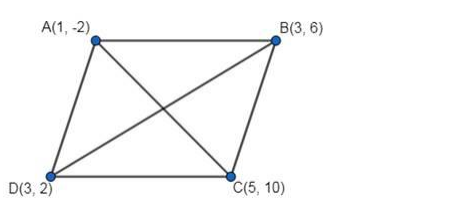Show that A(1, -2), B(3, 6), C(5, 10) and D(3, 2) are the vertices of a parallelogram.

Given: Vertices of the quadrilateral are $A(1,-2), B(3,6), C(5,10)$ and $D(3,2)$.
Note: For a quadrilateral to be a parallelogram opposite sides of the quadrilateral must be equal in length, and the diagonals must not be equal.
$A B=\sqrt{(3-1)^{2}+(6+2)^{2}}=\sqrt{4+64}$
$=2 \sqrt{1} 7$ units
$B C=\sqrt{(5-3)^{2}+(10-6)^{2}}=\sqrt{4+16}$
$=2 \sqrt{5}$ units
$C D=\sqrt{(3-5)^{2}+(2-10)^{2}}=\sqrt{4+64}$
$=2 \sqrt{17}$ units
$D A=\sqrt{(1-3)^{2}+(-2-2)^{2}}=\sqrt{4+16}$
$=2 \sqrt{5}$ units
Therefore, $A B=C D$ and $B C=D A$. ................(1)
$A C=\sqrt{(5-1)^{2}+(10+2)^{2}}=\sqrt{16+144}$
$=4 \sqrt{10}$ units
$B D=\sqrt{(3-3)^{2}+(2-6)^{2}}$
$=4$ units
Therefore, $A C \neq B D \ldots(2)$
From 1 and 2, we have
Opposite sides of ABCD are equal, and diagonals are not equal. Hence, points A, B, C and D are the vertices of a parallelogram.
Click here to get exam-ready with eSaral
For making your preparation journey smoother of JEE, NEET and Class 8 to 10, grab our app now.
